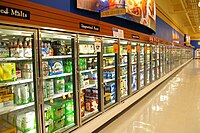
Photo from wikipedia
This study was conducted to evaluate the effect of genetic selection (Lines A and B; Line A pigs have a greater proportion of Pietrain genes than those from Line B… Click to show full abstract
This study was conducted to evaluate the effect of genetic selection (Lines A and B; Line A pigs have a greater proportion of Pietrain genes than those from Line B and therefore, selected for improved lean tissue accretion) on the feeding behavior of group-housed pigs exposed to daily cyclic high ambient temperatures. Feeding behavior of 78 barrows housed together in a single room was recorded in real time by five automatic feeders. The feeders registered each visit of each pig (day, hour, min, and second) and the amount of feed requested. Daily cyclic high ambient temperature was induced exposing pigs at 22°C from 18.00 to 10.00 h and 30°C from 10.01 to 17.59 h. From this temperature variation, day-period was divided into: 22°C(06-10h), from 6.00 to 10.00 h; 30°C(10-18h), from 10.01 to 17.59 h; and 22°C(18-06h), from 18.00 to 5.59 h. Meal criteria was estimated based on the probability of animals starting a new feeding event within the next minute since the last visit (Pstart). After defining the meal criteria, the number of meals (n), feed intake rate (g/min), feed intake (g/meal), feeder occupancy (min/meal), and interval between meals (min) of each animal were calculated. Greatest probability of starting to feed was observed at 22°C(06-10h), followed by 30°C(10-18h) and then 22°C(18-06h). Regardless of time period, pigs from line A had greater feed intake rate and lower feed intake, feed occupancy per meal and probability of starting a meal when compared with line B pigs. Only line A pigs had greater feed intake and feeder occupancy per meal at 22°C(18-06h) than remainder of the day. This indicates that pig feeding pattern is strongly related to the circadian rhythm. However, the genetic selection for improved lean tissue accretion may modulate pigs feeding behavior under daily cyclic high ambient temperatures.
Journal Title: PLoS ONE
Year Published: 2022
Link to full text (if available)
Share on Social Media: Sign Up to like & get
recommendations!